2 Chapter 2: Organization of Life
Chapter 2 Outline
2.1 Levels of Organization of Living Things
2.2 The Diversity of Life
2.3 Primate Evolution

Before you begin to study the different structures and functions of the human body, it is helpful to consider its basic architecture; that is, how its smallest parts are assembled into larger structures. It is convenient to consider the structures of the body in terms of fundamental levels of organization that increase in complexity: atoms, molecules, macromolecules (e.g. carbohydrates, lipids, proteins, and nucleic acids), organelles, cells, tissues, organs, organ systems, and organisms. It is also important to realize that humans and other living organisms interact with one another and the environment as the hierarchy of biological organization continues upward from organisms to populations, communities, ecosystems, and the biosphere.
Learning Objectives
Organization BioConcept
- You will understand the basic classification system of life and how this system reflects evolutionary relationships. Levels of an organism are cell, tissue, organ, organ system, organism, population, ecosystem.
- You will understand how life is organized into a progressive, hierarchical, and increasingly complex set of systems from the molecular level to the ecosystem level.
- You will be able to provide three examples to explain the emergent properties that arise from these increasingly complex levels of organization.
2.1 Levels of Organization of Living Things
Living things are highly organized and structured, following a hierarchy on a scale from small to large. The atom is the smallest and most fundamental unit of matter. It consists of a nucleus, containing protons and neutrons, surrounded by electrons (Figure 2.2). Atoms form molecules. A molecule is a chemical structure consisting of at least two atoms held together by a chemical bond. Many molecules that are biologically important are biomolecules (also called macromolecules), which are large molecules that are typically formed by combining smaller units called monomers. An example of a biomolecule is deoxyribonucleic acid (DNA) (Figure 2.3), which contains the instructions for the functioning of the organism that contains it. Other important biomolecules used by living organisms besides nucleic acids include proteins, carbohydrates, and lipids.
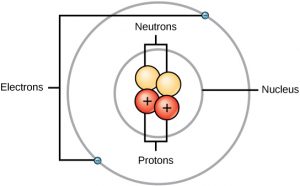
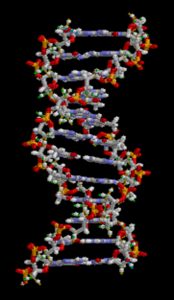
Figure 2.3 A molecule, like this large DNA biomolecule, is composed of atoms. (credit: “Brian0918″/Wikimedia Commons). To see an animation of this DNA molecule, click here (http://openstaxcollege.org/l/rotating_DNA2) .
Some cells contain aggregates of biomolecules surrounded by membranes; these are called organelles (Figure 2.4). Organelles are small structures that exist within cells and perform specialized functions (ex- mitochondria make ATP, chloroplasts make glucose by photosynthesis). All living things are made of cells; the cell itself is the smallest fundamental unit of structure in living organisms. Cells have all of the properties of life, which include that they are composed of biomolecules, the ability to metabolize, composed of cells, maintain homeostasis, respond to external stimuli, grow and reproduce, and evolve. (Viruses are not considered living because they are not made of cells. To make new viruses, they have to invade and hijack a living cell; only then can they obtain the materials they need to reproduce.) Some organisms consist of a single cell and others are multicellular. Cells are classified as prokaryotic or eukaryotic. Prokaryotes are single-celled organisms that lack organelles surrounded by a membrane and do not have nuclei surrounded by nuclear membranes (Figure 2.5); in contrast, the cells of eukaryotes do have membrane-bound organelles and nuclei (Figure 2.4).
a. Animal Cell
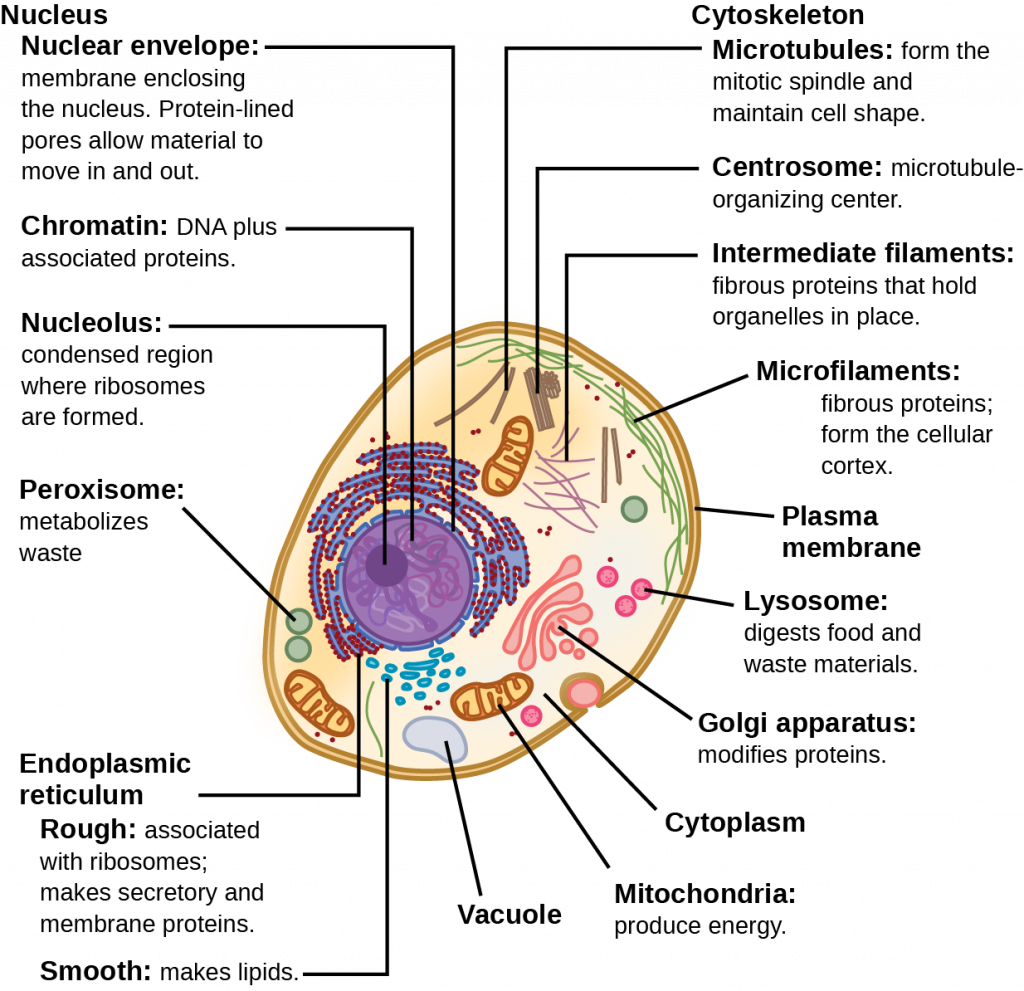
b. Plant Cell
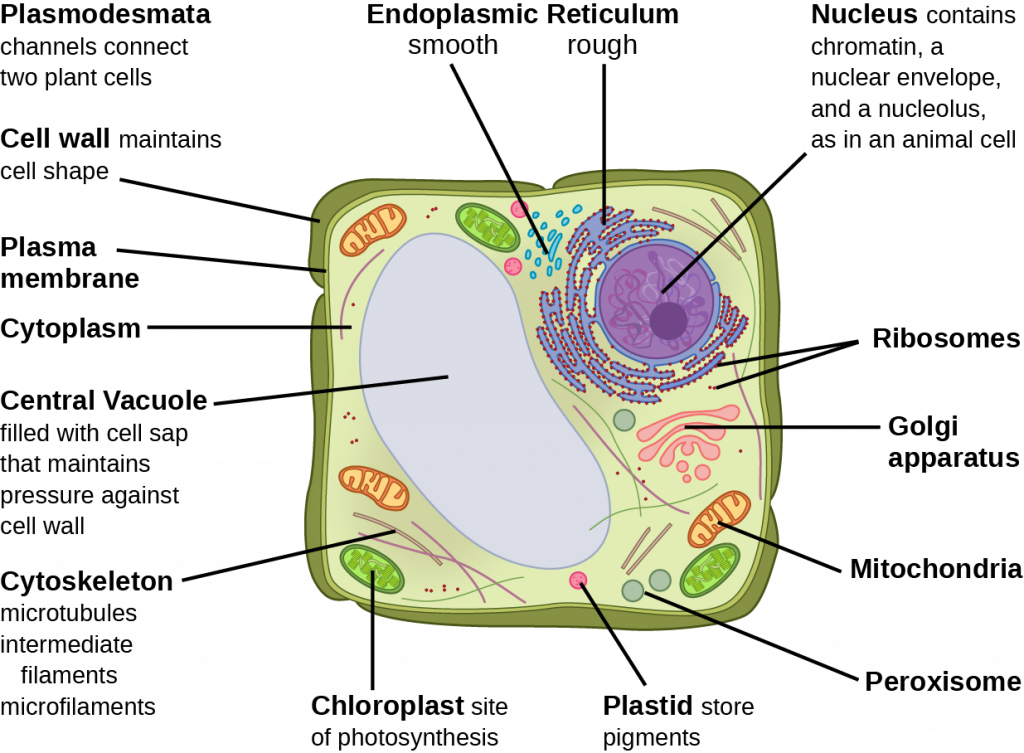
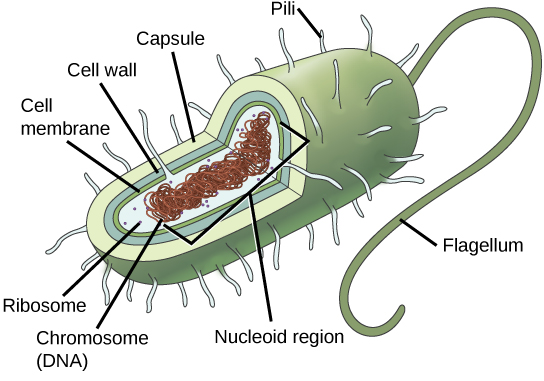
In most multicellular organisms, cells combine to make tissues, which are groups of similar cells carrying out the same function (ex- muscle tissue, nervous tissue, epithelial tissue, connective tissue). Organs are collections of two or more tissue types grouped together based on a common function. Organs are present not only in animals but also in plants. An organ system is a higher level of organization that consists of functionally related organs. For example vertebrate animals have many organ systems, such as the circulatory system that transports blood throughout the body and to and from the lungs; it includes organs such as the heart and blood vessels. Organisms are individual living entities. For example, each tree in a forest is an organism. Single-celled prokaryotes and single-celled eukaryotes are also considered organisms and are typically referred to as microorganisms.
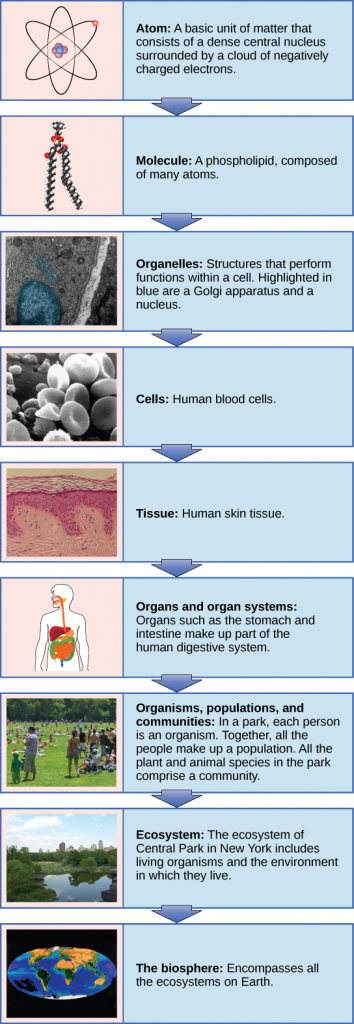
All the individuals of a species living within a specific area are collectively called a population. For example, a forest may include many white pine trees. All of these pine trees represent the population of white pine trees in this forest. Different populations may live in the same specific area. For example, the forest with the pine trees includes populations of flowering plants and also insects and microbial populations. A community is the set of populations inhabiting a particular area. For instance, all of the trees, flowers, insects, and other populations in a forest form the forest’s community. The forest itself is an ecosystem. An ecosystem consists of all the living things in a particular area together with the abiotic, or non-living, parts of that environment such as nitrogen in the soil or rainwater. At the highest level of organization (Figure 2.6), the biosphere is the collection of all ecosystems, and it represents the zones of life on Earth. It includes land, water, and portions of the atmosphere.
It is important to note that the structural arrangement and functional properties of one level in the hierarchy of biological organization are important to the structure and function of the next level. New properties emerge (called emergent properties) at the next level as the individual parts interact that are not seen at the levels below. For example, cells such as neurons do not have the property of thinking. But if the neurons are arranged into nervous tissue and then into the organ, the brain, the emergent property of thinking becomes evident.
2.2 The Diversity of Life
The science of biology is very broad in scope because there is a tremendous diversity of life on Earth. The source of this diversity is evolution, the process of gradual change during which new species arise from older species.
In the 18th century, a scientist named Carl Linnaeus first proposed organizing the known species of organisms into a hierarchical taxonomy (taxonomy is the science of naming and classifying organisms). In this system, a species is defined as a group of organisms that can reproduce with each other in nature and produce fertile offspring. Species that are most similar to each other are put together within a grouping known as a genus. Furthermore, similar genera (the plural of genus) are put together within a family. This grouping continues until all organisms are collected together into groups at the highest level. The current taxonomic system now has eight levels in its hierarchy, from lowest to highest, they are: species, genus, family, order, class, phylum, kingdom, domain. Thus species are grouped within genera, genera are grouped within families, families are grouped within orders, and so on (Figure 2.7).
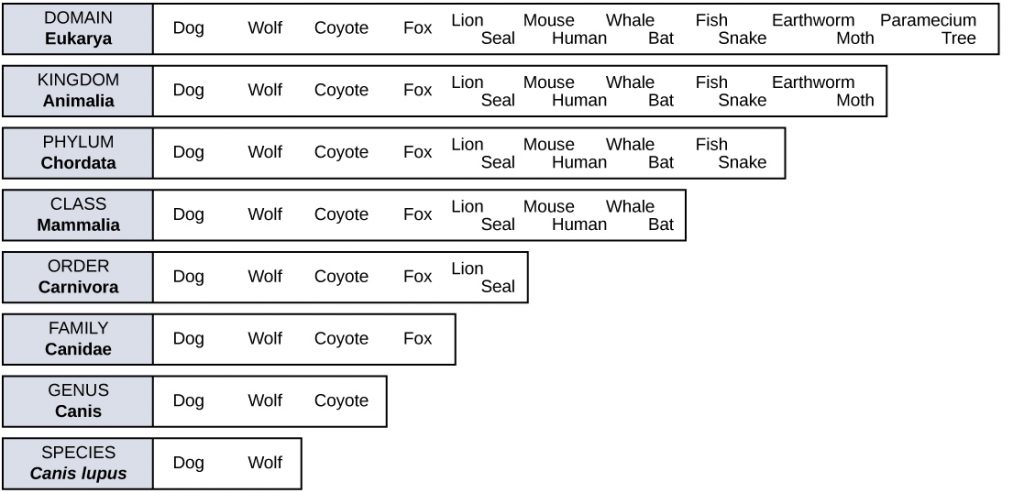
The highest level, domain, is a relatively new addition to the system since the 1990s. Scientists now recognize three domains of life, the Eukarya, the Archaea, and the Bacteria. The domain Eukarya contains organisms that have cells with nuclei. It includes the kingdoms of fungi, plants, animals, and protists. In domain Eukarya, humans belong to the animal kingdom. The Archaea, are single-celled organisms without nuclei and include many extremophiles that live in harsh environments like hot springs. The Bacteria are another quite different group of single-celled organisms without nuclei (Figure 2.8). Both the Archaea and the Bacteria are prokaryotes, an informal name for cells without nuclei. The recognition in the 1990s that certain “bacteria,” now known as the Archaea, were as different genetically and biochemically from other bacterial cells as they were from eukaryotes, motivated the recommendation to divide life into three domains. This dramatic change in our knowledge of the tree of life demonstrates that classifications are not permanent and will change when new information becomes available.
In addition to the hierarchical taxonomic system, Linnaeus was the first to name organisms using two unique names, now called the binomial naming system. Before Linnaeus, the use of common names to refer to organisms caused confusion because there were regional differences in these common names. Binomial names consist of the genus name (which is capitalized) and the species name (all lower-case). Both names are set in italics when they are printed. Every species is given a unique binomial which is recognized the world over, so that a scientist in any location can know which organism is being referred to. For example, the North American blue jay is known uniquely as Cyanocitta cristata. Our own species is Homo sapiens.

2.3 The Evolution of Primates
In phylum Chrodata (chordates are organisms that have a spinal cord), order Primates of class Mammalia includes lemurs, tarsiers, monkeys, apes, and humans. The vast majority of non-human primates live primarily in the tropical or subtropical regions of South America, Africa, and Asia. They range in size from the mouse lemur at 30 grams (1 ounce) to the mountain gorilla at 200 kilograms (441 pounds). The characteristics and evolution of primates are of particular interest to us as they allow us to understand the evolution of our own species.
Characteristics of Primates
All primate species possess adaptations for climbing trees, as they all descended from tree-dwellers (Figure 2.9). This arboreal heritage of primates has resulted in hands and feet that are adapted for climbing, or brachiation (swinging through trees using the arms). These adaptations include, but are not limited to: 1) a big toe that is widely separated from the other toes (except humans) and opposable thumbs to allow them to firmly grasp branches, 2) claws that have been modified into flattened fingernails and toenails, 3) binocular vision, in which the eyes both face forward, resulting in two overlapping fields of vision from the eyes that allows for depth perception and gauging distance, important for climbing and leaping between trees, 4) mobile shoulder joint for tree-climbing 3) large brains that are bigger than those of most other mammals, and 5) typically single-birth, meaning only one offspring per pregnancy.
Concepts in Biology by Samantha Fowler, Rebecca Roush, and James Wise, published by OpenStax, licensed under CC BY 4.0, click here to access for free.
Human Biology by Willy Cushwa, published by OpenStax CNX, licensed under CC BY 4.0, click here for access for free.
Biology 2e by Mary Ann Clark, Matthew Douglas, and Jung Choi, published by OpenStax, licensed under CC BY 4.0, click here to access for free.
Media Attributions
- Helium atom
- DNA
- Eukaryotic cell structure
- Plant cell
- prokaryotic cell
- Heirarchy
- Taxonomy
- Domains

